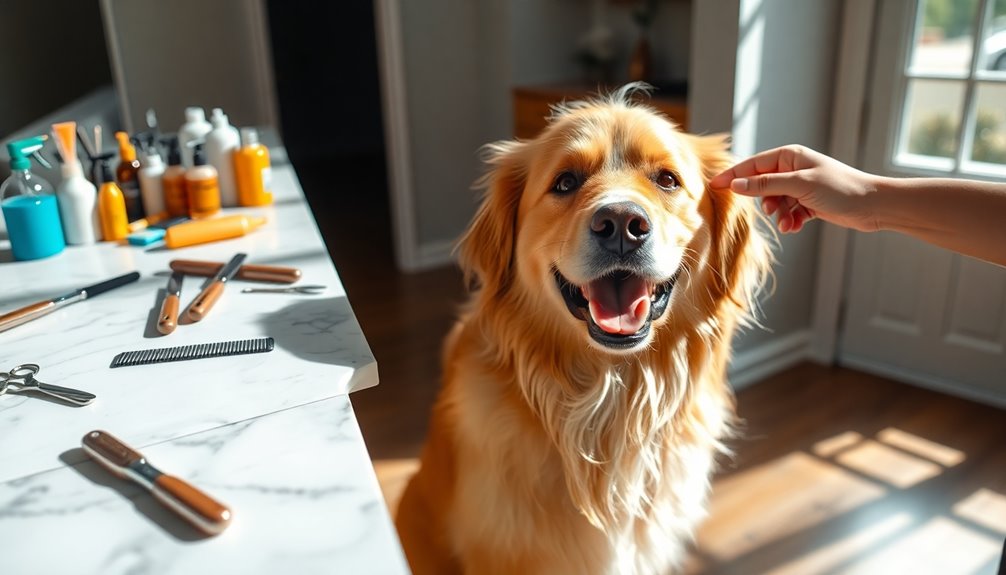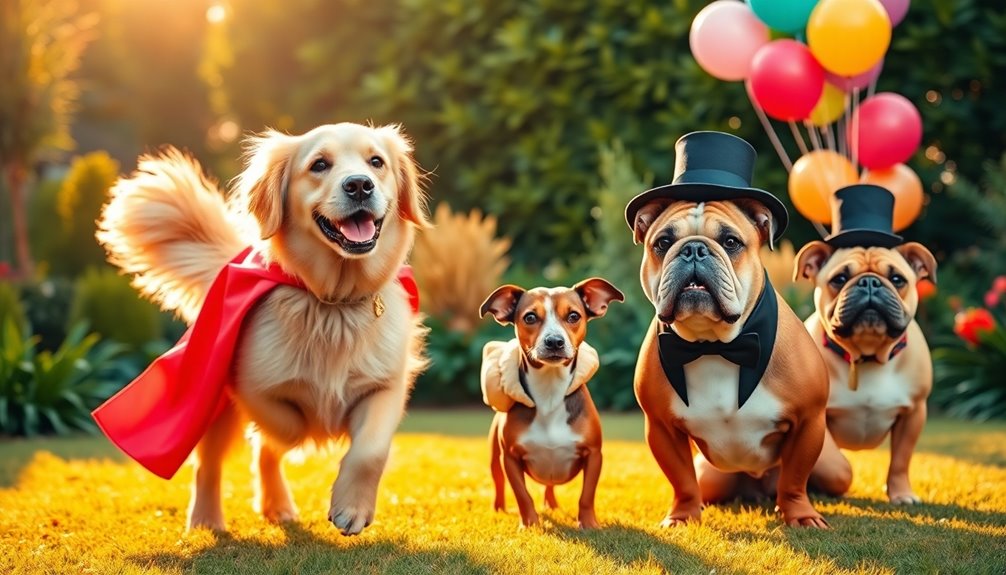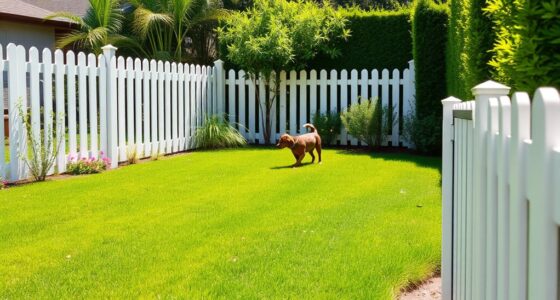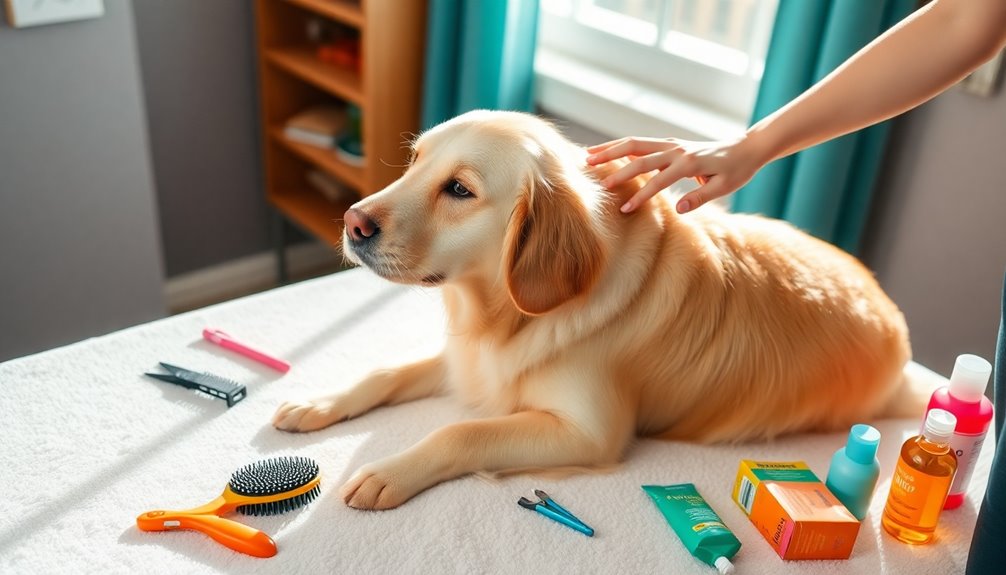Your dog's grooming routine is essential for their health and happiness. It's not just about looking good; regular grooming removes dirt, allergens, and loose fur, helping to prevent skin irritations and early detection of health issues. Depending on your dog's coat type, you'll need to brush and bathe them at specific intervals. Nail trimming and ear cleaning are equally important for comfort and prevention of infections. Establishing a routine fosters trust and reduces anxiety, making the process smoother for both of you. Discovering the best practices can elevate your grooming game further.
Key Takeaways
- Regular grooming is essential for maintaining your dog's skin and coat health, preventing irritations, and detecting potential health issues early.
- Grooming frequency varies by coat type: short-coated dogs need less frequent grooming than long or double-coated breeds.
- At-home grooming supports maintenance between professional sessions, helping manage shedding and matting effectively.
- Establishing a consistent grooming routine fosters trust and reduces anxiety, improving your dog's overall comfort during sessions.
- Positive reinforcement during grooming strengthens the bond between you and your dog while ensuring a smoother experience.
Health Benefits of Grooming

Grooming your dog isn't just about keeping them looking good; it's essential for their health. A consistent grooming routine enhances skin and coat health by removing dirt, allergens, and loose fur, leading to healthier skin and reducing the risk of infections. Bathing your dog helps eliminate allergens, dust, and parasites, which prevents skin irritations and promotes a shiny coat.
Regular grooming sessions also facilitate early detection of skin conditions, infections, or tumors. This allows you to seek timely veterinary care, ensuring your dog stays healthy.
Furthermore, don't forget about dental care—brushing your dog's teeth and offering dental treats can greatly reduce plaque buildup and gum disease, preventing systemic health issues later on.
Beyond these health benefits, grooming fosters bonding between you and your dog. These sessions can reduce stress and anxiety, enhancing their overall well-being. Additionally, regular grooming can help reinforce positive reinforcement techniques that contribute to your dog's training and behavior.
Essential Grooming Techniques
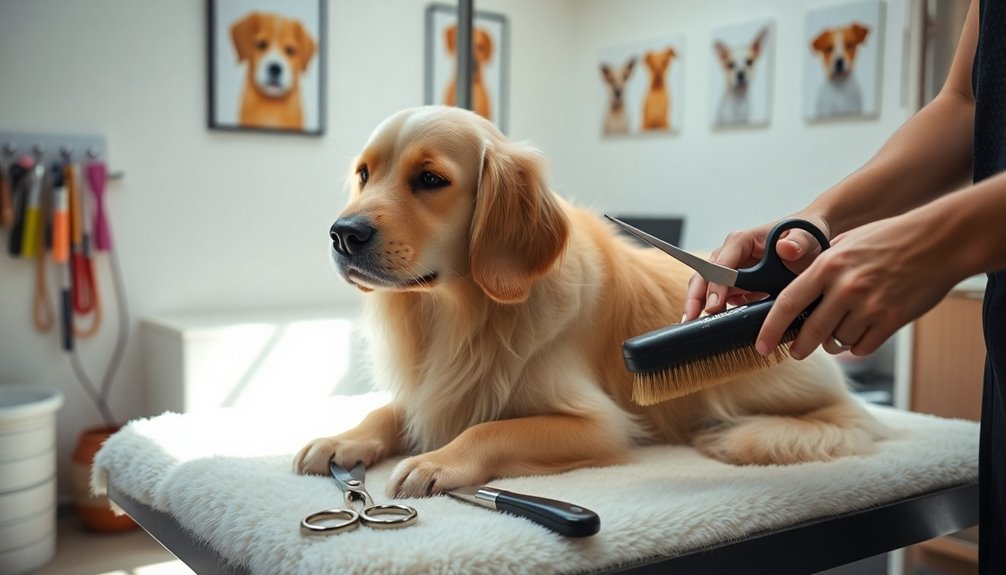
To keep your dog looking and feeling their best, mastering essential grooming techniques is key. Regular brushing is important for maintaining your dog's coat health. For short-coated dogs, brush 1-2 times weekly, while long-coated dogs need 3-4 times. Bathing with dog-specific shampoo should occur every 4-12 weeks, ensuring you rinse thoroughly to avoid skin irritation.
Nail trimming is essential every 3-4 weeks to prevent discomfort and gait issues. Use sharp clippers and be cautious around the quick. Ear cleaning can prevent infections, so use a dog ear cleaner and cotton balls regularly, keeping an eye out for excess wax or irritation. Don't forget about dental hygiene; brush your dog's teeth 2-3 times a week with dog-specific toothpaste to maintain overall health.
Here's a quick reference table for your grooming routine:
| Grooming Task | Frequency | Tools Needed |
|---|---|---|
| Regular Brushing | 1-2x (short) / 3-4x (long) | Grooming tools |
| Nail Trimming | Every 3-4 weeks | Sharp clippers |
| Ear Cleaning | Weekly or as needed | Dog ear cleaner, cotton balls |
| Bathing | Every 4-12 weeks | Dog shampoo, water |
| Dental Hygiene | 2-3 times a week | Dog-specific toothpaste |
At-Home vs. Professional Grooming

When it comes to grooming your dog, you've got two main options: professional services or at-home techniques.
Professional groomers bring specialized skills and tools to tackle complex styles, while at-home grooming helps maintain your dog's coat between visits.
Finding the right balance between both can keep your dog looking and feeling great.
Benefits of Professional Grooming
Finding the right balance between at-home grooming and professional services can greatly enhance your dog's health and appearance.
While grooming at home fosters comfort and familiarity, professional grooming offers specialized knowledge of different coat types and breeds. This expertise is essential for handling complex cuts and trims that can be challenging to achieve on your own.
Depending on your dog's breed, you might need professional grooming every 4 weeks or a few times a year to maintain ideal coat health and appearance.
This regular maintenance not only keeps your dog looking great but also helps prevent mats and skin issues that can arise from neglect.
At-Home Grooming Techniques
Using effective at-home grooming techniques can greatly enhance your dog's coat health and overall well-being. As a pet owner, establishing a regular grooming routine is crucial.
Brushing your dog not only helps manage shedding but also reduces matting, which can lead to skin conditions if left unattended. During these sessions, you can spot early signs of issues like infections or parasites, allowing for timely veterinary care.
While professional groomers have the expertise and tools for more complex grooming tasks, your at-home grooming efforts can complement their services. Regular brushing and bathing maintain your dog's coat between professional visits, fostering a sense of comfort and reducing anxiety during grooming sessions.
Combining at-home grooming with professional appointments optimizes coat health and appearance. You can handle basic grooming tasks, while professional groomers can manage intricate styles or cuts tailored to your dog's breed.
This partnership not only promotes your dog's physical health but also strengthens the bond between you and your furry friend, fostering trust and cooperation during grooming activities.
Preparing for Grooming Sessions
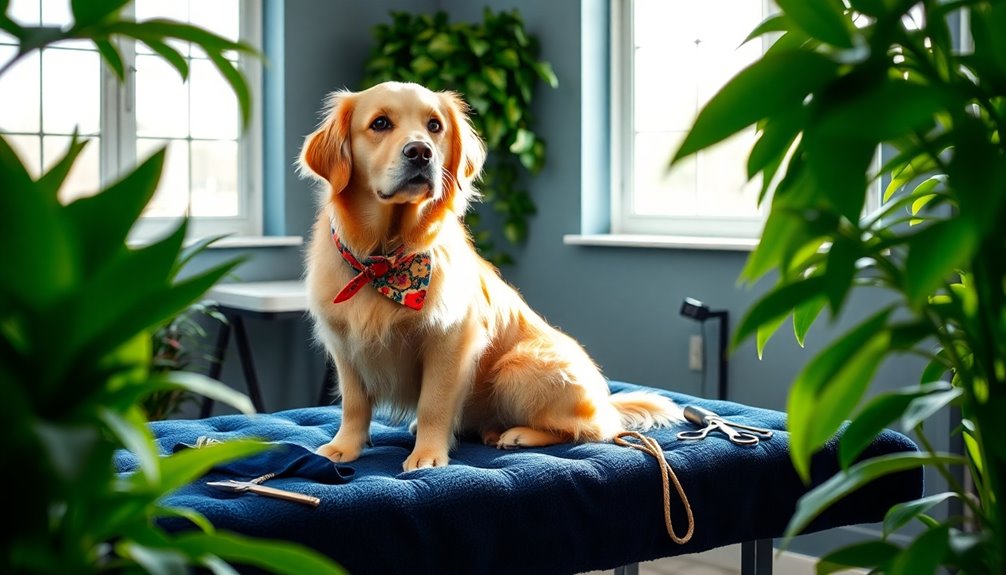
To guarantee a smooth grooming experience, start by selecting a quiet, well-lit area with a non-slip surface where your dog can feel stable and comfortable. This calming environment is essential for easing any anxiety your dog might've during grooming sessions.
Next, gather your grooming tools—brushes, combs, nail clippers, and toothbrushes—ensuring they're in good condition and suited for your dog's coat type.
Introduce the grooming tools gradually, using treats to create a positive association. This approach helps your dog view grooming as a rewarding experience rather than a chore.
Establish a consistent grooming routine that matches your dog's needs; for instance, short-coated dogs typically require brushing 1-2 times weekly, while long-coated dogs need brushing 3-4 times a week.
Always be prepared for each session by having all supplies ready and ensuring you're in that quiet area. A consistent approach not only builds trust between you and your pet but also helps them feel secure.
Finding the Right Grooming Balance

When it comes to grooming your dog, striking the right balance between at-home care and professional services is key. Your dog's individual needs depend on their breed, coat type, and lifestyle. By evaluating these factors, you can create a grooming routine that promotes their health and comfort.
Here's a simple guide to help you find that balance:
- Short-coated breeds: Brush 1-2 times weekly and bathe every 6-12 weeks.
- Long-coated breeds: Brush 3-4 times weekly and bathe every 4-6 weeks.
- At-home grooming: Regular brushing maintains coat health and reduces the need for frequent professional visits.
- Professional grooming: Use these services for tasks like trimming and thorough cleaning, ensuring your dog stays comfortable and healthy.
Combining at-home grooming with professional services not only optimizes your dog's coat health but also allows for early detection of any potential issues.
Tailor your grooming routine to your dog's temperament and gradually introduce tools to make the experience positive.
With the right balance, grooming can be a rewarding experience for both you and your furry friend.
Grooming Routine Steps

To keep your dog healthy and happy, you'll want to follow a consistent grooming routine.
Start with the essential steps like brushing, bathing, nail trimming, ear cleaning, and dental care, adjusting the frequency based on your dog's needs.
Essential Grooming Frequency
Establishing a consistent grooming routine is key to keeping your dog healthy and looking their best. Understanding the essential grooming frequency for your dog's coat type is crucial. Here are some dog grooming tips to follow:
- Short-coated dogs: Brush 1-2 times a week and bathe every 6-12 weeks. This keeps their coat clean and healthy.
- Medium-coated dogs: Brush 1-2 times a week and schedule bath time every 6-8 weeks to remove loose fur and dirt.
- Long-coated breeds: Brush 3-4 times a week and bathe every 4-6 weeks to prevent matting and maintain coat health.
- Nail trimming: Every 3-4 weeks is necessary to avoid discomfort and potential gait issues.
In addition to these grooming sessions, remember that your dog's ears should be checked weekly for dirt, and you should perform daily dental care by brushing your dog's teeth with dog-specific toothpaste.
Step-by-Step Grooming Process
A well-planned grooming routine not only keeps your dog looking great but also supports their overall well-being.
Start the grooming process by brushing your dog thoroughly. This step removes tangles and loose fur, helping to prevent mats and skin irritation before you bathe your dog. Use a dog-specific shampoo and warm water to guarantee a clean coat, making sure to rinse thoroughly to avoid any residue that could irritate their skin.
After bathing, it's important to clean the ears. Use a dog ear cleaner and a cotton ball to prevent moisture buildup and potential infections.
Next, move on to nail clipping. Trim your dog's nails every 3-4 weeks to maintain comfort and prevent pain, being cautious not to cut into the quick.
Finally, conclude the grooming session by checking your dog's teeth. Brushing your dog's teeth 2-3 times a week is vital to prevent dental issues and promote overall health.
Frequency of Grooming by Coat Type

Many dog owners mightn't realize how grooming frequency varies by coat type, but it's vital for maintaining your pet's health and cleanliness.
Understanding your dog's specific needs can make a significant difference in their coat health and overall wellbeing.
Here's a quick guide to help you establish an effective grooming routine based on coat type:
- Short-Coated Dogs: Brush 1-2 times a week and bathe every 6-12 weeks to minimize shedding.
- Medium-Coated Dogs: Brush 1-2 times a week and bathe every 6-8 weeks to prevent matting.
- Long-Coated Dogs: Brush 3-4 times a week and bathe every 4-6 weeks to avoid tangles.
- Double-Coated Dogs: Groom at least twice weekly and bathe every 6-12 weeks, especially during shedding season.
For low-shedding dogs, you'll need to brush 4-5 times a week and schedule haircuts every 6-8 weeks.
Regular brushing and controlled bathing frequency are essential for keeping your dog's coat looking great and healthy.
Pay attention to your dog's specific coat type to guarantee the best care possible.
Behavioral Impact of Grooming
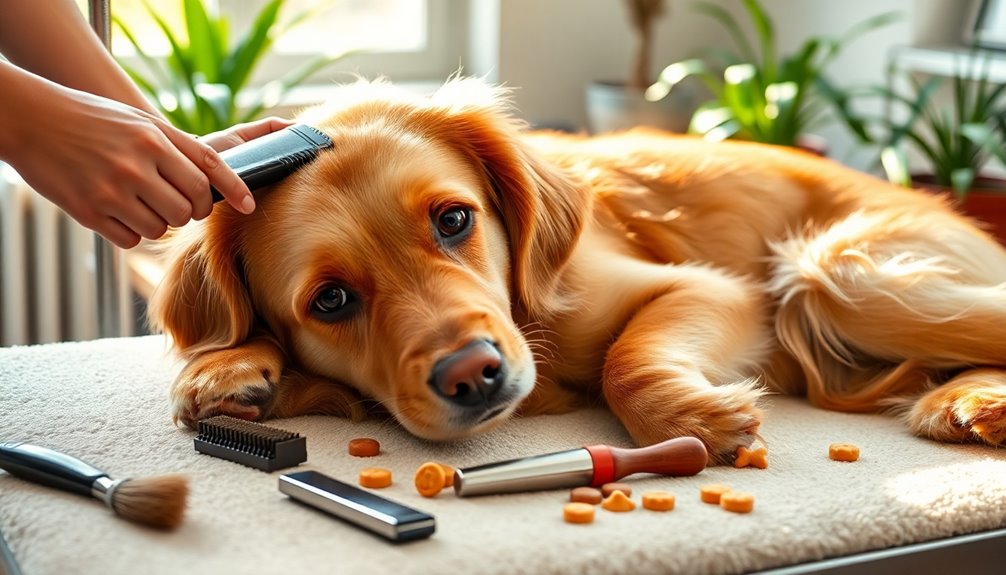
Grooming your dog regularly can greatly influence their behavior and emotional well-being. Establishing a consistent grooming routine helps reduce anxiety by providing your dog with a predictable process they can rely on. When you groom your dog often, you enhance trust and cooperation, leading to a more positive grooming experience.
Dogs that experience frequent grooming sessions adapt to the routine more easily, fostering a sense of security that can minimize stress-related behaviors. Conversely, disruptions in established grooming schedules can trigger anxious behaviors, underscoring the importance of maintaining a regular routine.
Taking a methodical approach to grooming not only improves efficiency but also promotes a calmer demeanor in your dog during sessions. The behavioral impact of grooming is significant; when your dog knows what to expect, they feel more at ease. Additionally, positive reinforcement can be beneficial during grooming to encourage good behavior and reduce anxiety.
Frequently Asked Questions
What Is Rule #1 for Grooming a Dog?
Rule #1 for grooming your dog is to establish a consistent grooming routine.
By creating familiarity with the process, you help reduce your dog's anxiety and make it easier for them to adapt to grooming tasks over time.
Regularly brushing your dog, bathing them when needed, and trimming their nails every few weeks are all part of this routine.
Consistency builds trust, making grooming a more enjoyable experience for both of you.
How Much Do You Tip a $70 Dog Groomer?
When tipping a $70 dog groomer, aim for 15% to 20%, which translates to about $10.50 to $14.
If the groomer exceeded your expectations or took extra care with your dog, consider tipping 20% or even more, totaling $14 to $17.
If you used a mobile grooming service, you might want to tip around 20% to 25% due to the added convenience.
Always check the grooming salon's policy on tipping first!
What Are the 7 Steps of Grooming a Dog?
Grooming your dog's like tending a garden; each step nurtures their well-being.
Start by brushing their coat to clear away debris, then bathe them with a gentle shampoo, ensuring you rinse thoroughly.
After drying, trim their nails carefully every 3-4 weeks to keep them comfortable.
Finally, clean their ears and brush their teeth.
These seven steps, including regular maintenance, cultivate a healthy, happy companion, much like a flourishing flower in full bloom.
How Do Groomers Keep Dogs Still While Grooming?
Groomers keep dogs still during grooming by using gentle restraint techniques, like holding them comfortably or securing them on grooming tables with safety straps.
They create a calming environment, using soothing tones and treats to reduce anxiety.
Tools like grooming muzzles or harnesses help guarantee safety while preventing sudden movements.
Familiarizing your dog with the grooming process beforehand can also make a big difference in their comfort and cooperation during the session.
Conclusion
Grooming your dog isn't just about keeping them looking good; it's about maintaining their health, enhancing their comfort, and strengthening your bond. By establishing a routine that suits your dog's coat type and needs, you'll promote a happier, healthier life. Whether you choose at-home care or professional services, remember: consistency is key, patience is crucial, and love is essential. So grab your tools, set a schedule, and enjoy the grooming journey together!

